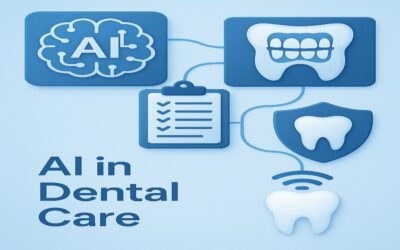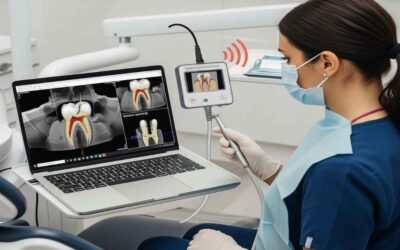From Research to Real-World Results
Contents
Not long ago, artificial intelligence in dental care felt like science fiction. Today, it is a clinical reality. Whether it is detecting cavities early, predicting gum disease, or spotting signs of oral cancer, AI in dentistry is making life easier for dentists—and safer for patients.
The exciting part is, these are neither fiction nor experiments anymore. There are growing numbers of AI success stories in dental clinics showing that this tech works in real-life practice. This blog highlights how AI is changing dentistry for the better—right now.
The Big Picture: Why AI Matters in Dentistry
Let us start with what is at stake.
The most prevalent oral health issues in the world are dental caries (cavities) and periodontal disease (gum problems).
Oral cancer is ranked as the 6th most common cancer in the world, and India has the most cases of oral cancer, the most common among men and the third most among women in the country.
That is a significant public health burden to bear. That is where AI in dentistry is stepping in to help dentists identify problems earlier, improve treatments, and provide care to more at-risk populations, particularly those that are rural and underserved.
Real-World Clinical Highlights: AI Success Stories in Dental Clinics
These three case studies show how AI is not just helpful—it is game-changing in daily dental practice.
1. Fighting Cavities with AI
Study by Geetha et al. in India (2020)
What they did:
Used a neural network (basically a smart computer model) to analyze X-rays and spot early cavities.
- Dataset: 105 radiographs
- Technology used: Back-propagation neural network
- Accuracy: 97.1%
- False positives: Just 2.8%
Why it matters:
Dentists sometimes miss small cavities, especially if they are hidden by plaque or overlapping teeth. This AI model caught those early and did it well—perfect for rural clinics or schools where early detection can save teeth.
2. Smarter Gum Disease Detection
Study by Jundaeng et al. in Thailand (2025)
What they did:
Used an AI model (YOLOv8) to read panoramic dental X-rays and measure bone loss caused by gum disease.
- Dataset: 2,000 patient X-rays
- Accuracy:
- Tooth segmentation: 97%
- Bone level detection: 98%
- Overall diagnosis: 94.4%—better than experienced periodontists!
Why it matters:
Gum disease generally goes unrecognized until it is too late, for many patients. Our AI-assisted general dentists in identifying it before harm was done, assisting us with better referrals, improved treatment speed, and healthier smiles.
3. Early Detection of Oral Cancer
Study by Kharche et al. in India (2024)
What they did:
Developed an AI system that analyses mouth images to detect signs of cancer.
- Tools used: Intraoral cameras, X-rays, and AI-powered deep learning
- Success rate: Over 90% accurate in spotting cancerous lesions
Why it matters:
Invasive biopsies can often be frightening and costly. This tool identifies cancer signs early and without a scalpel. It is currently used in mobile dental units to screen people in underserved regions. In India where oral cancer is a big issue, innovations of this kind can save lives.
How Else Is AI Helping Dentists Today?
AI is showing up everywhere in modern dental care. Here are a few more ways it’s making things better—for both clinics and patients.
1. Smarter X-Ray Reading
AI can now scan X-rays, CBCTs, and 3D scans to:
- Spot early cavities, cysts, or bone issues
- Flag anything suspicious for a second look
- Cut down on human error
Tools like U-Net and commercial AI radiograph readers are already approved for clinical use—and making a difference.
2. Predicting Dental Risks Before They Happen
AI can look at patient data (like health history, diet, or bone density) and predict things like:
- Who’s at risk for cavities
- If an implant might fail
- Early signs of gum disease
This helps dentists offer better, more personalized care.
3. Virtual Assistants & Chatbots
Ever scheduled a dental appointment through a chatbot? That’s AI.
These tools help clinics:
- Book appointments
- Answer common questions
- Share post-op instructions
- Talk to patients in different languages
It saves time, reduces front-desk workload, and keeps patients happy.
4. Reaching Underserved Populations
In many places, especially rural areas, access to dentists is limited. AI helps with:
- Remote screenings via mobile phones
- Teledentistry using AI analysis
- Sending dental vans to high-risk areas based on predictive maps
It’s helping countries like India expand care to millions.
5. Smarter Health Campaigns
Instead of generic advice, AI helps public health departments:
- Target high-risk groups (e.g., smokers or diabetics)
- Send reminders in the right language and format
- Adjust messaging based on what works best
This improves engagement and leads to better habits and outcomes.
6. Treatment Planning and Simulations
Dentists now use AI tools for:
- Designing dental crowns, bridges, or dentures
- Planning orthodontic treatments
- Simulating how a tooth will move with braces
This improves precision and saves both time and cost.
7. Running the Clinic More Efficiently
AI also helps behind the scenes:
- Automates insurance claims
- Sends appointment reminders
- Manages inventory based on usage
- Predicts busy days for better staffing
It’s all about working smarter—not harder.
Conclusion: The Future of Dentistry Is Already Here
There is no question—AI in dentistry is fundamentally changing the face of dentistry, for the better. From early cavity detection, to cancer screening, to a more efficient clinic, to assisting entire communities, AI is doing it all.
And the best news? These aren’t just experiments. These are real-world, AI success stories in dental clinics across the globe.
Dentists utilizing AI are not being replaced—they are being empowered. The question is no longer whether AI will be part of dentistry—but when will your clinic use it?






0 Comments